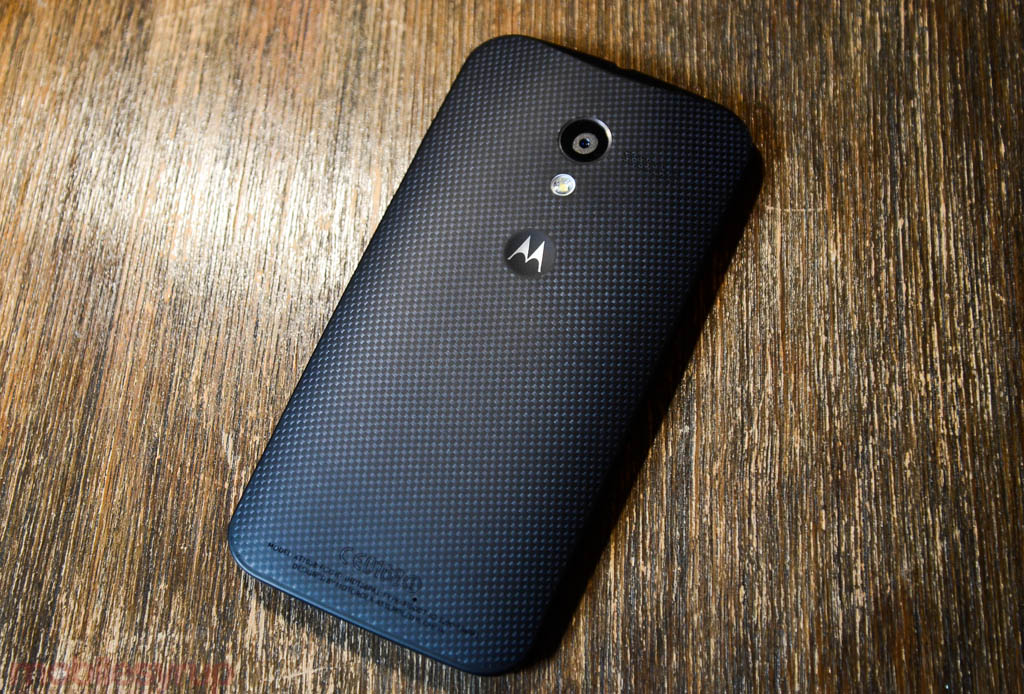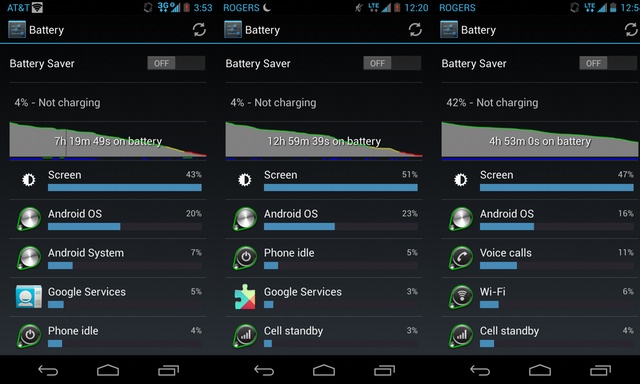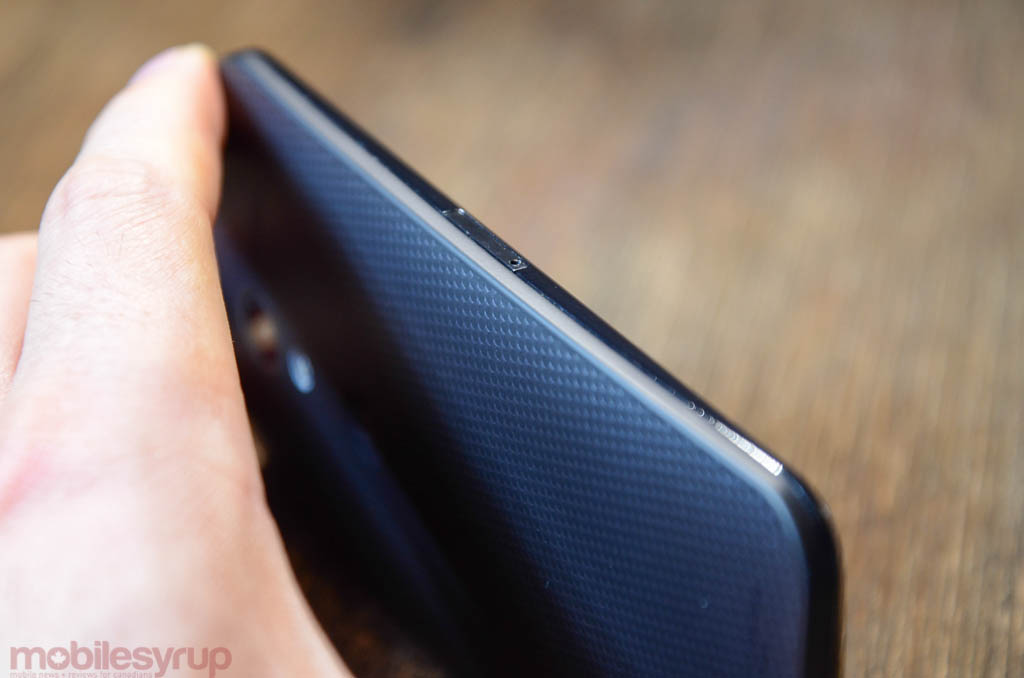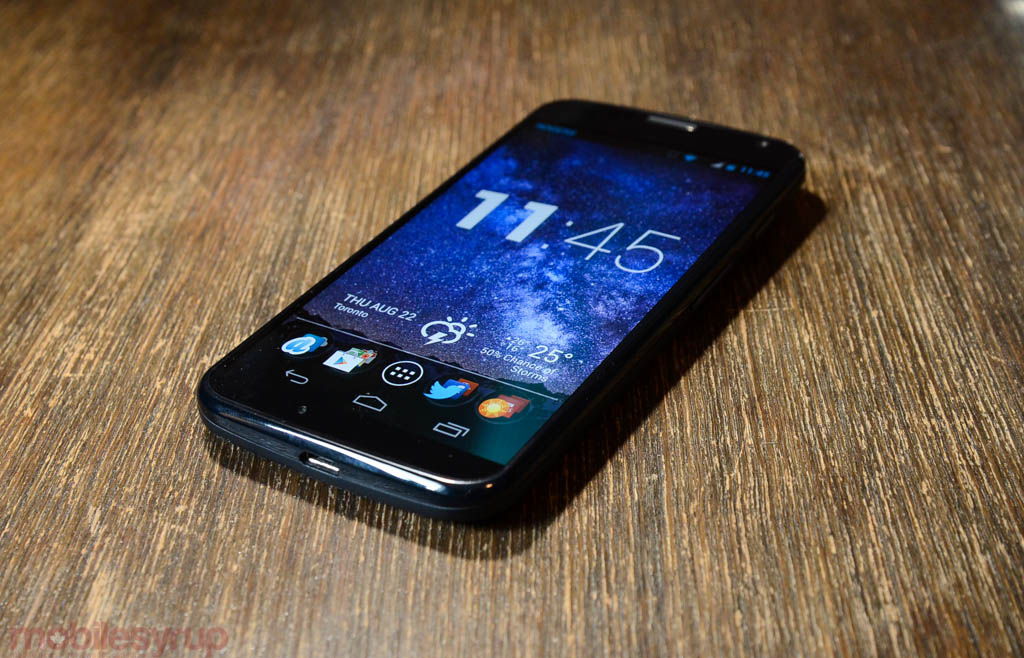
When I was a child, the anticipation of watching a treasured movie, even after the fourth of fifth viewing, would thrill me. I’d kick back, my legs swaying off the couch, a bowl of popcorn dwarfing my tiny body. I was truly, blissfully happy.
It was the familiarity of that ritual, the joy of returning to something easy and good, that excited me so. Years later, it’s the lingering feeling, not the movies themselves, that I remember most.
All this is to say there is a semblance of the anti-Goldilocks in the smartphone world today; we’re trained to replace our devices quickly, and covet new ones even more so. What’s pleasing in our hands one day is tired the next. It’s a never-ending train of disappointment, inflicted on ourselves by the propensity to want bigger, faster, devices.
With the Moto X, I don’t get that feeling. I don’t concern myself with how quickly it will feel dated or how long it will take me to covet some new handset. Like the iPhone 4, which still today feels modern, the Moto X exists outside the venerated smartphone wolf pack. It’s not necessarily a better phone, though it exudes elements of superiority, but it’s the best whole Android experience I’ve ever had.
Specs
- Android 4.2.2 Jelly Bean
- 1.7Ghz dual-core Snapdragon S4 processor, X8 combo w/ natural language processor and contextual computing processor
- Adreno 320 GPU @400Mhz
- 4.7-inch 1280×720 pixel AMOLED display
- 2GB DDR2 RAM
- 16GB internal storage (non-expandable)
- 10MP rear camera
- 2MP front-facing camera
- 1080p video capture @ 30fps
- WiFi (ac/a/b/g/n), Bluetooth 4.0 LE, A-GPS, GLONASS, NFC
- 129.3 x 65.3 x 10.4 mm
- 130g
- HSPA+ 850/1900, LTE 700/1700/2100/2600Mhz
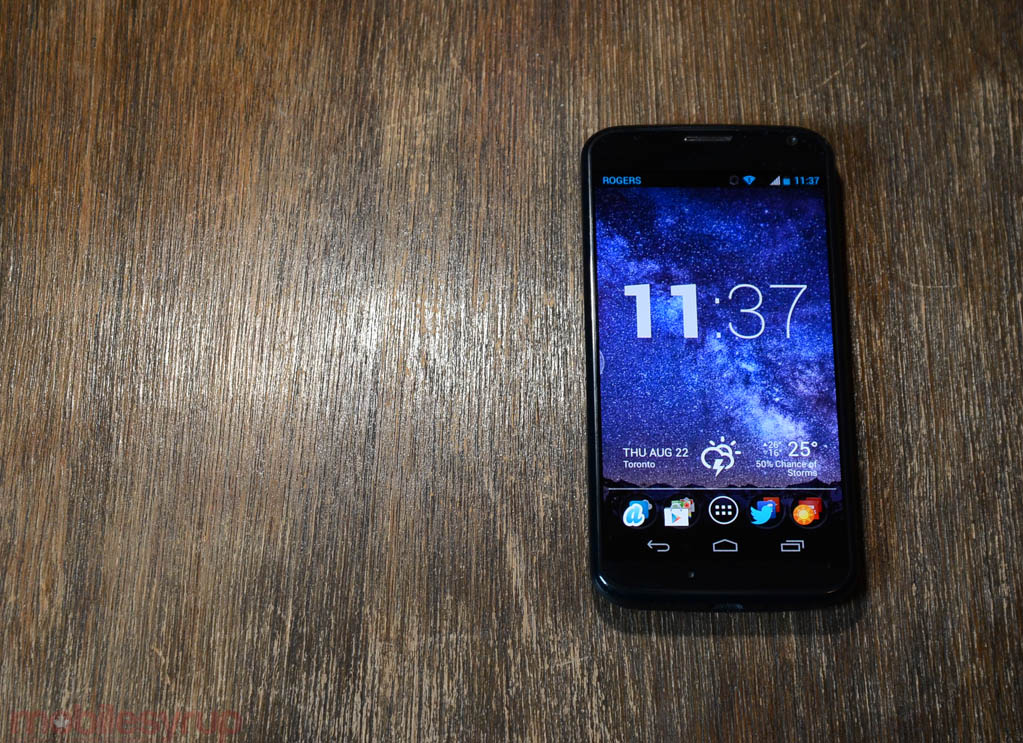
Design
There’s something effortless about holding the Moto X in your hand, and it continues to be the reason, above all others, that I pick it up, day after day. Motorola has made a lot of its curved back and dimpled Moto logo in which your index finger rests, but there’s something else.
Cast your mind back to when Samsung first unveiled the Galaxy S3; they claimed it was inspired by nature, like holding a smooth pebble. Such comparisons are more apt for the Moto X, which boasts a compact frame that almost melts into the palm. Its density is equally distributed from top to bottom, and the polycarbonate chassis boasts proportions more appropriate for the average-sized hand than any flagship smartphone in recent memory.
The materials used to surround the Moto X, especially the rubbery backing, is more akin to the matte plastic on the Nokia Lumia series than any Samsung device you may have held, but the most accurate comparison is, ironically, to the Samsung-built Nexus 10. It’s clear that the Moto X is built from two distinct pieces, and on the black model I reviewed they clash slightly. The small perimeter of glossy plastic to the sides of the Gorilla Glass screen attract fingerprints, while dust and grit get caught between the two elements. The modular construction model necessitates this design direction, but devices like the iPhone 5 and HTC One have proven that single-piece construction is preferable.
Also a concern are the volume and power buttons, which are located vertically on the right side of the device. These do not live up to the same high quality standards as the rest of the phone, as they tend to rattle around in their enclosures.
But those minor issues should not detract from the fact that this is one of the most comfortable, well-made phones on the market today. Though the front is fairly unassuming — it may be mistaken for a Nexus 4 by a less experienced smartphone buyer — the minute bezel to the right and left of the AMOLED display, and the minimal affectation — unlike the US variants, there is no carrier logo on the back — adds to the impression of completeness.
It’s apparent that Motorola thought long and hard about how the phone would be used; this is a fully-realized device, from the symmetrical placement of the dimpled Motorola logo under the camera sensor to the soft repeating texture. The phone curves in on itself, narrowing to 5mm at the rounded corners; the headphone jack is placed in the same place on top as the microUSB port is on bottom. And you’d be hard-pressed to believe the 720p display is actually 4.7-inches diagonally.
It’s just that well designed.
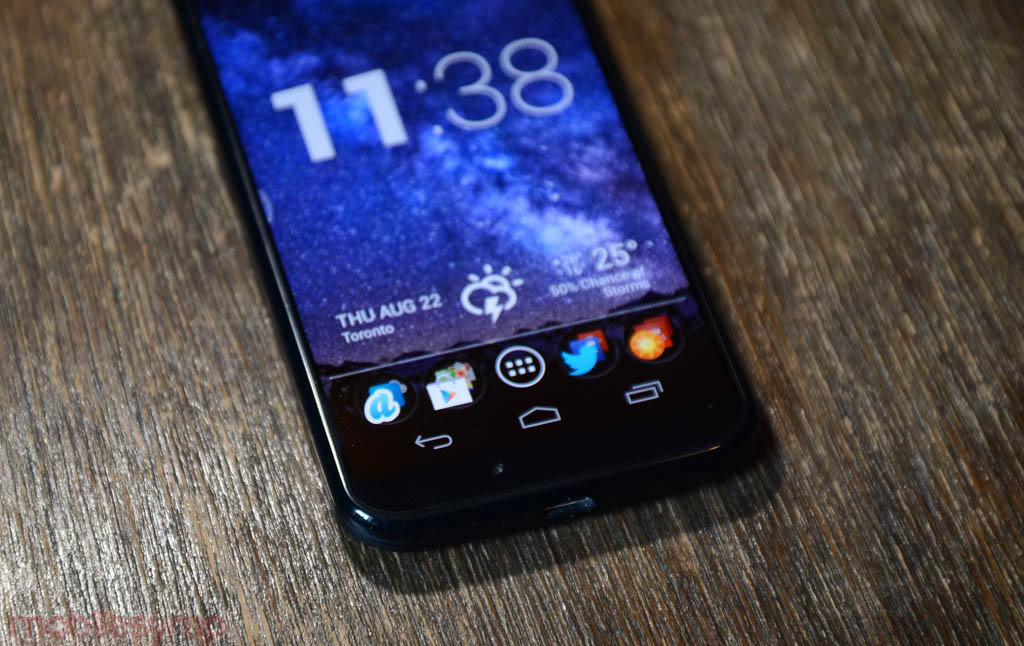
Display
You’ve likely already read about the Moto X, and have probably already decided whether its 720p display is an important spec. (The dichotomy of specs versus experience will continue to be an important theme of this review.)
In short, the 720p display on the Moto X is great, though not the best. Unlike that of the Galaxy S3, the AMOLED display, which provides rich, deep colours and perfect blacks, is not PenTile, but made of three regular subpixels for every pixel. In fact, it uses a similar RGB layout to the Galaxy Note II, though the 4.7-inch size makes for a significantly higher 317ppi pixel density.
With excellent viewing angles and moderately high maximum brightness, the screen never disappoints. And thanks to AMOLED’s ability to light up only select pixels at a time, it enables my favourite feature of the device: Active Notifications.
There may be some that call it a travesty to market a 1280×720 pixel display as a flagship, especially in light of competing OEMs moving to 1080p. While I never found the screen lacking in sharpness — indeed, I often couldn’t discern between them unless studying two devices side by side — there is an argument to be made for value that I can only attempt to disavow.
The 720p display on the Moto X is perfect for its size, weight and hardware combination. A 1080p display more heavily taxes the GPU and the battery, and adds nothing of value to the Android experience, especially in a device of this size. Full HD is a spec, and the race to the top is one that Motorola wisely chose to stay away from.
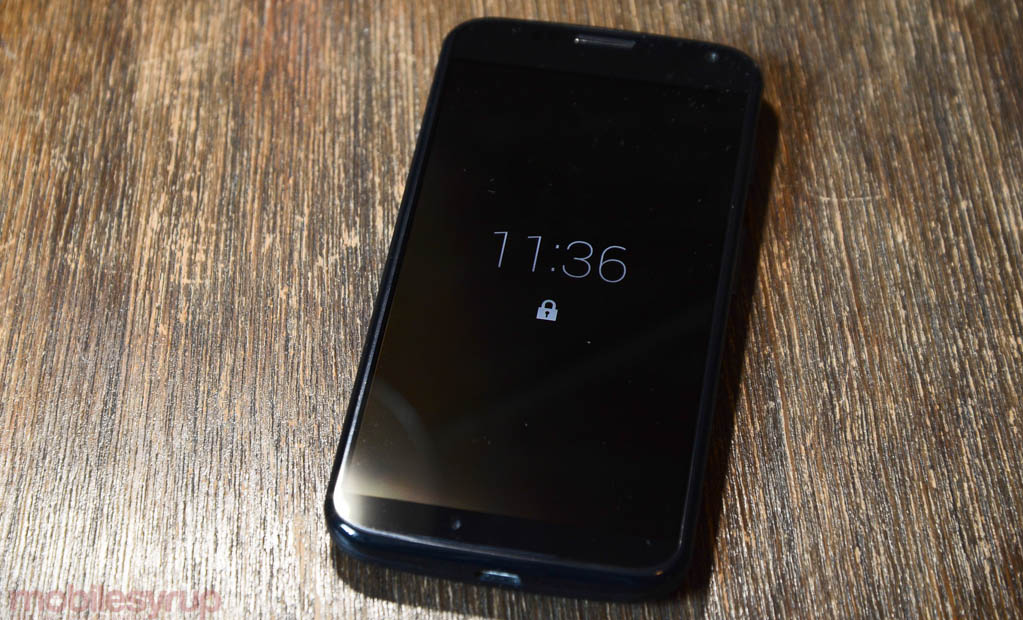
Software
The Moto X runs a slightly altered, but largely unfettered, build of Android 4.2.2. The experience speaks to Google’s influence, if not direct involvement, in the decisions that led up to the phone’s creation.
More important is that Motorola’s four major additions sit atop the OS, and replace none of the core functionality. Impressively, each one builds on Android’s strengths, coalescing into an experience that forms a greater whole.
First, we’ll talk about my favourite feature: active notifications. Instead of a blinking LED, the Moto X breathes new notifications on the screen as they appear. Due to the nature of AMOLED screen technology, this only marginally engages the battery, as power is drawn only from the lit pixels themselves. You can choose to action the notification or let it breathe, which is one of the more attractive effects I’ve seen on a smartphone. The only real limitation here is that only the latest notification is actionable; the others are set below the unlock button and briefly summarize the content.
But the Moto X has a “contextual computing processor” inside of it, which detects when a user is bringing the phone out of his or her pocket, or lifting it off the table. The phone’s screen lights up when you want it to, like a perfectly-trained pet, displaying the time and most recent information. While I wish this would go further — if there are no notifications, for instance, you can’t set the phone to display the weather or information from Google Now — but as it stands, this is one of those features I wish every phone had. I’ve since used the iPhone 5 or HTC One and find myself disappointed at their sombre, blank faces.
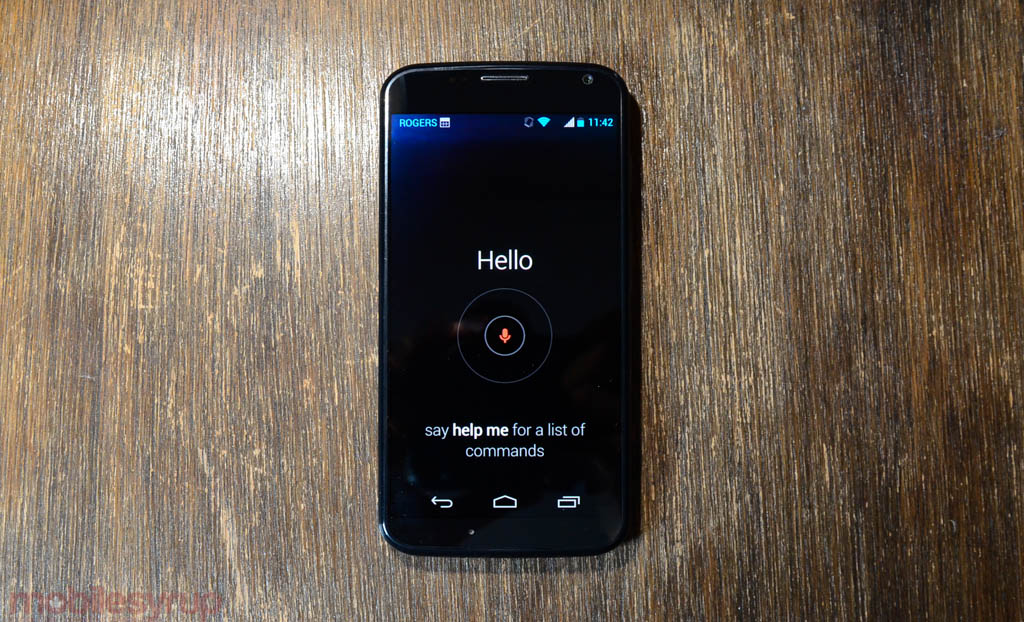
Then there is Touchless Control, which integrates Google Now with the company’s “natural language processor.” The phone has a l0w-level chip that constantly listens for a voice — your voice, in particular — to ask a question or issue a search.
By stating, “OK, Google Now,” the phone comes to life and connects to Google Now’s growing database of context-specific semantic language, from “What’s the weather going to be today?” to “Remind me to pick up the kids from karate at 5pm.”
The feature is useful only when security is disabled, which turns out to be a huge liability. You can activate the voice prompt, but it will only continue once a password manually entered. Motorola has designed accessories to get around this, but at the end of the day it’s an inelegant solution to an important problem.
Active Notifications and Touchless Controls, the latter of which will not be used as often as the first, are broadly populist in nature, appealing less to the spec hoarders and feature creepers than to the average user who just wants his or her phone to work better under regular circumstances. Admittedly, there haven’t been that many scenarios in which I’ve needed to use Touchless Controls, or found it to be quicker than merely unlocking my phone, sliding up on the virtual home button and typing a request into Google, but there’s been a true sense or purpose over the 10 or so times I have used it.
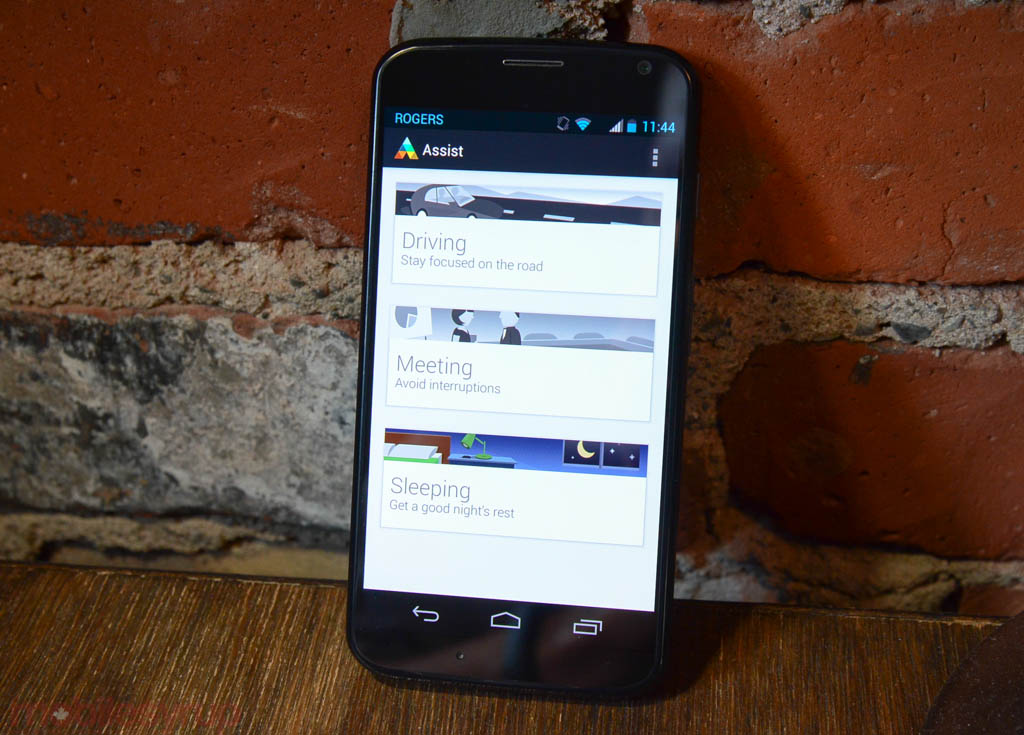
Motorola Assist is the evolution of Smart Actions, heaping yet another bit of context to the smartphone experience. Using the GPS, it knows when you’re driving (or in a car) and speaks your text messages; it knows when you’re sleeping and silences your phone; and it knows, based on your calendar, when you’re in a meeting, and sends an auto-reply to any incoming calls or texts.
There are only three modes, and they’re all a little underdeveloped — for example, if you’re still awake once the phone turns to sleep mode, you can tell it to go back to normal, but can’t manually turn it back on again — but extremely useful.
The beauty of these features are that they’re built atop Android; they can be added to without issuing a system update. Motorola has already released a Touchless Controls app to Google Play, so the feature set can be expanded independent of system version.
But not all is harmonious in the software world of Moto X. Stock Android this may look like, but Motorola is still at the whim of carrier certification, slowing down potential updates. That the phone doesn’t ship with Android 4.3, despite the company being owned by Google, is a concern. The RAZR HD was one of the first devices to receive Android 4.2, but unlike a Nexus product it’s not clear for how long Motorola will continue to support the Moto X. The company insists it is fully proxied from the Android team, so as not to proffer unfair advantage, but in this situation I wish it was afforded some advantage.
All the requisite Android 4.2.2 features are included, such as lock screen widgets and a quick settings toggle in the notification shade. As you’ll see in the next section, it doesn’t take a quad-core beast to power Android properly — the platform has reached a semblance of maturity in that regard — and the Moto X delivers one of the most enjoyable Android experiences to date.
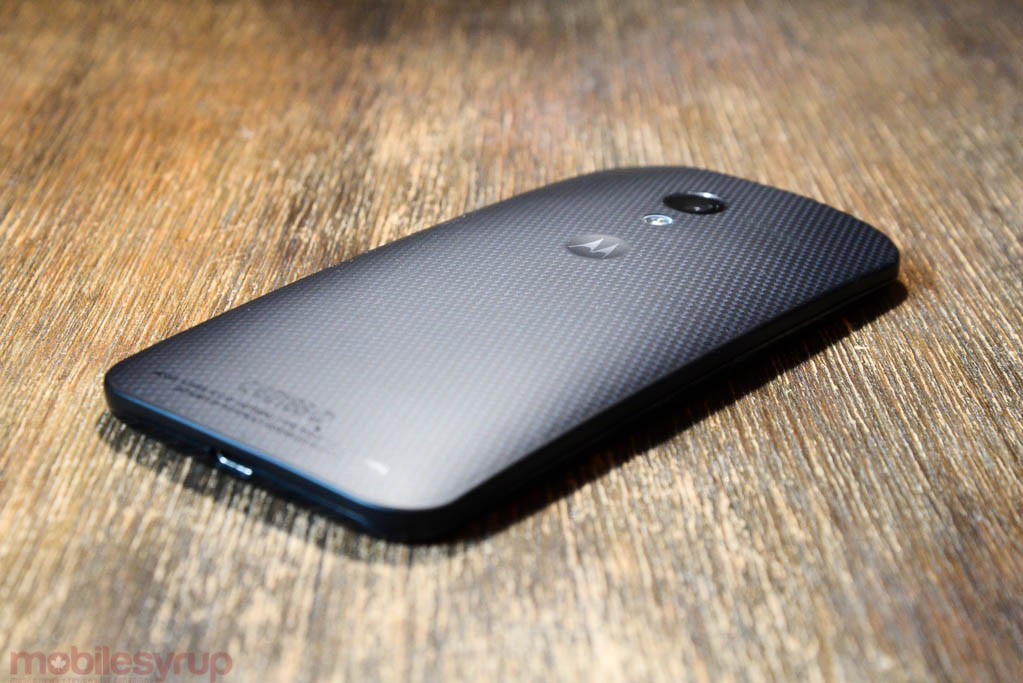
Performance
One of the most controversial aspects of the Moto X, aside from its 720p display, is the fact that it only runs a dual-core processor. Why, in the age of quad-core Snapdragon 800 running at desktop-equivalent clocks, did Motorola shortchange its users with just a Qualcomm Snapdragon 8960dt SoC running at 1.7Ghz?
The argument is a non-starter; the Moto X runs flawlessly. Not only does it have more than ample headroom to power even the most arduous of apps and games, but I’d argue that the phone has been sufficiently optimized to run faster than most devices on the market.
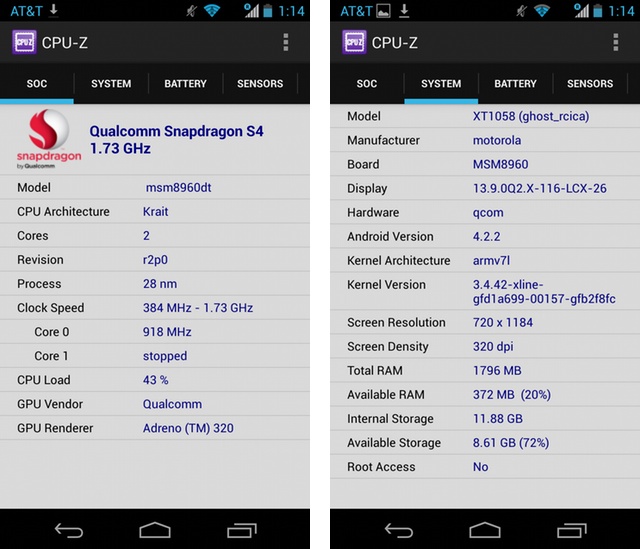
Unfortunately, this is not going to assuage those looking for top value, which usually equates to higher specs at a lower price. I have nothing to say to this other than right now the subjective delta between a dual-core Snapdragon S4 Pro and a quad-core Snapdragon 600 is, outside of synthetic benchmarks, almost non-existent. In two years — by the end of a contract — that may not be the case, which is a legitimate concern, but we’ve reached the point where two year old phones are running Android 4.2 just fine.
The Moto X also seems to have been designed to scale well. It may have “just” dual-core processor, but its Adreno 320 GPU only has to push half the number of pixels as the HTC One and Samsung Galaxy S4.
Camera
The 10MP camera on the Moto X has dual personalities. In optimal lighting conditions, the RGBC sensor — it’s the first phone sensor with a clear subpixel used to capture more light at the equivalent shutter speed — takes wonderful, articulate photos. Detail and dynamic range are usually excellent, and colour reproduction, while muted, is more accurate than most high-end devices.
But it’s in low light that this phone’s Dr. Jekyll emerges; in spite of a sensor with 1.4 micron pixels and higher light sensitivity, photos that the HTC One, iPhone 5, Galaxy S4 and Lumia 920 would have no trouble with are riddled with aberrations like pockmarks on a bumpy road.
The camera interface is fairly simple, and the shutter button is the entire display. Motorola emphasizes speed and simplicity here, and to that end a shortcut has been set up to enter the camera app from anywhere — lockscreen or an app — by quickly twisting your wrist twice. It’s a gesture that takes some getting used to, and only works 75% of the time, but when performed deliberately — the times it didn’t register were when I wasn’t really giving it my full attention — it becomes a natural extension of your workflow.
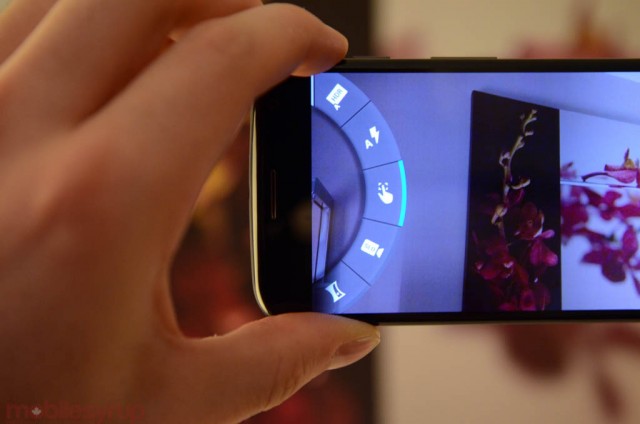
The camera app lacks controls that many take for granted on other devices, even Google’s own Nexus products. One cannot adjust white balance, ISO, exposure or contrast. In fact, though the app does support tap-to-focus, it does so only in the bounds of taking a photo; one cannot focus and then wait to steady the hand. It’s a system that works most of the time, but engenders a multi-capture culture. It’s easy to take many shots at once, though: just hold down your finger on the screen and the processor does the work.
HDR is turned on by default, though the app decides on your behalf when best to incorporate it. HDR photos turned out better, and saved faster, than on the Galaxy S4 or iPhone 5, but I found the HTC One still produced the best combinations in difficult lighting. For example, when taking a photo of a shady tree with a blue sky in the background, the Moto X handled it well, but the HTC One still beat it for overall quality.
Still, 10MP is nothing to sneeze at, and when it’s good, it’s really good. I expect that, as with the HTC One and Galaxy S4, Motorola will continue to tweak and add to the camera experience in future updates. The sensor is good, but we found the ISO and white balance algorithms to misjudge the scene in low light. Photos had a sepia tinge and an ISO over 2500, causing massive amounts of grain. The photos were plenty bright, so we think the app just needs to apply the settings more assiduously, or let us do it if desired.
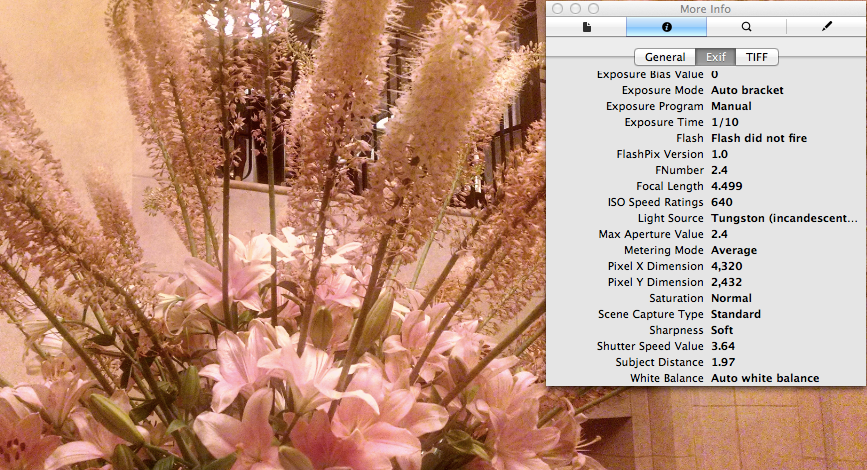
When you dig more closely into the camera’s behaviour, you can see that it is assigning one of a series of white balance settings to the photo. Most of the low-light photos, even ones taken outdoors, skew yellow because ‘Tungston’ is selected as the light source. It’s possible to use an app like Camera FV-5 to manually adjust the settings of a photo before taking it, but doing so largely negates the quick draw nature of the built-in camera app.
Video capture, 1080p at 30fps, was also good, though we found the lack of stabilization to be a problem when moving. Though audio capture was some of the best we’ve experienced, though it distorts at higher volumes, we’re acclimatizing to a life of optical image stabilization, and the Moto X lacks the hardware necessary to prevent blur and shakiness.
Similarly disturbing is the drop in frame rate and bandwidth in areas of motion and low light. To compensate for the lack of image stabilization, the processor attempts to prevent blur by manually lowering the video bitrate and shutter speed. It’s not necessarily unusual for this to happen, but it speaks to the limitations of phone-sized camera sensors.
Battery Life
Motorola promises 24 hours of “mixed usage,” which equates to using the Moto X normally, without overtaxing the various components by watching too many YouTube videos or playing hours of rymdkapsel.
But the promises were just that; in spite of a 2200mAh cell, battery life has consistently been my biggest complaint, and the one thing keeping me from feeling completely at home with the phone.
I will give it this: on a typical day, I am able to eke out 12 to 16 hours of use, though, as with the camera, some days are better than others. I don’t change my routine much, and rarely tax my phone beyond streaming a few minutes of YouTube or playing some Wind-up Knight, but on Monday the phone will be dead by 2pm and Tuesday it will go ’til 8.
My more quantifiable tests showed that the phone nets around the same uptime as the HTC One when streaming video at 65% brightness when connected to WiFi. The Moto X lasted for 6 hours, 23 minutes; the HTC One lasted 6 hours, 49 minutes (running a leaked version of Android 4.2.2). Turning off Active Notifications and Touchless Controls, which I preferred not to do, netted an extra half hour of uptime in these tests, but did not demonstrably affect day-to-day usage.
Battery life is an ongoing troublemaker for Android manufacturers, who only seem to be able to solve it by making bigger phones with larger batteries. Motorola decided to keep the phone compact, lower the screen resolution and use a stepped battery that filled up the entirety of the curved rear shell. I’d say they got 75% of the way there — this won’t be a true “24 hour device,” even if you count 6-10 hours of sleep in there — but it should last most users most of the day.
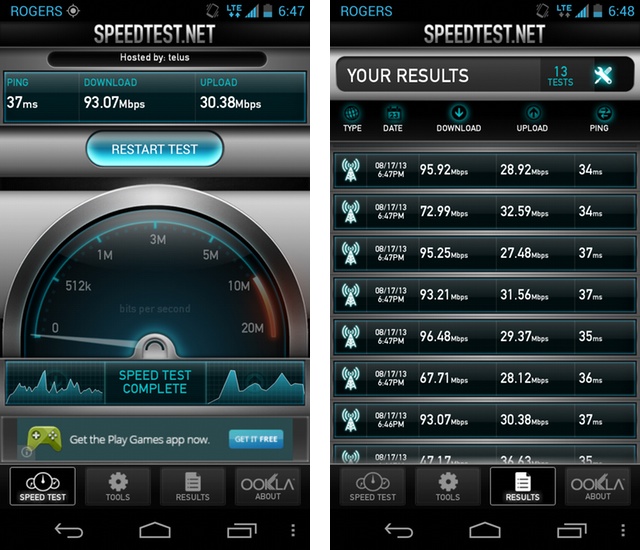
Connectivity
Say what you will about carrier exclusives, but Rogers has treated this phone very, very well.
Compatible with the company’s LTE Max network, which means that it is capable of running on both AWS and 2600Mhz (in addition to 700Mhz when it becomes available), I was able to achieve speeds faster than any other handset to date.
The device also supports WiFi speeds of up to 400Mbit/s over Wireless-AC, a new standard that is slowly being rolled out across router lines by Belkin (who now owns Linksys), Asus, D-Link and Netgear. This, in addition to 5Ghz wireless hotspot support, makes it the first device with consistently fast RF I’ve used, both in and outside the home.
Phone calls made over the Rogers network were unsurprisingly crisp and clear, as Motorola has a penchant for including excellent audio stacks and precise headpiece hardware. Similarly, despite the rear mono speaker, the Moto X can blast some pretty fantastic sound, beating out the iPhone 5 and Galaxy S4 and rivalling the HTC One. Audio capture is also quite good, though the One trounces it handily. Maximum volume also doesn’t come near the HTC One, both from the speaker or the headphone jack, but the output quality comes close.
Most importantly, the Moto X is one of the most comfortable smartphones I’ve used in the past two years, and its size enables both comfortable typing on a virtual keyboard and endless talking when held up to the ear.
The Moto X lacks wireless charging, which I will forgive, but it does support Miracast for screen mirroring to a compatible display. What I can’t forgive is the lack of expandable memory in light of the phone’s 16GB of internal storage, 11GB of which is usable. All phones should now come standard with 32GB of storage. Android has a growing ecosystem of great content and 16GB is just not enough. I’d happily pay extra for a 32GB version.
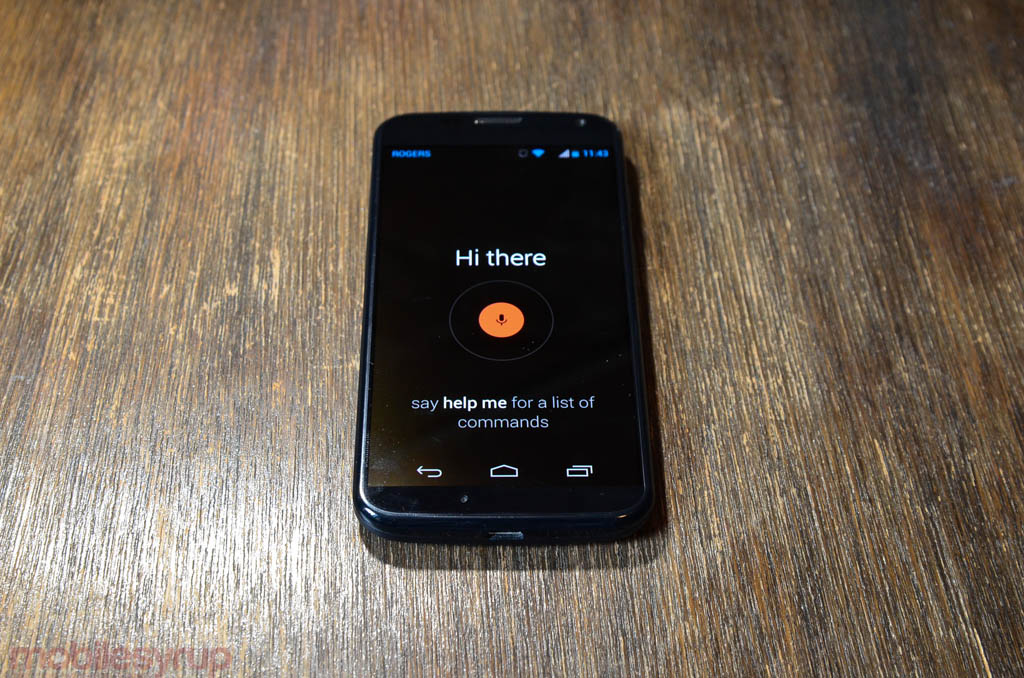
Final Thoughts
Many Canadians have dismissed Moto X as a mid-range phone with a high price, doomed to serve out its life on the shelves of a single carrier.
Let’s address these issues one by one.
Specs
The Moto X has a dual-core processor and a 720p display. Neither of these are considered high-end anymore because Android manufacturers have been playing the one-up game since Motorola and LG released the first dual-core phones in early 2011.
Why do we hold Android phones to a different standard than other manufacturers? It’s almost a certainty that the iPhone 5S will carry a dual-core processor and the equivalent of a 720p display. Similarly, this generation of Windows Phones have been surviving quite well on the same dual-core Snapdragon S4 chip, which is trounced by the 8960dt inside the Moto X. As long as the software is optimized for that particular piece of hardware, and apps, games and media run well on the hardware, why does it matter whether a phone comes with a dual- or quad-core chip?
Similarly, give me a high-quality 720p over a mediocre 1080p display any time. Unlike the jump from WVGA and qHD to 720p, it’s often difficult to discern a quantifiable difference in sharpness between 720p and 1080p.
Price
You think the Moto X is too expensive? At $189.99 on a 2-year term, maybe it is. But it will come down, and will likely stay below the HTC One and Galaxy S4. More importantly, the phone is some $100 and $150 cheaper respectively when bought outright, indicating that though Motorola and Rogers are marketing it as a premium handset, the OEM is actually selling it for considerably less.
At the same time, Moto X is Motorola’s flagship phone, and needs to address the market that way. The company is in a difficult position: a device that relies on the buyer actually holding and using it for some time to understand its worth is far more difficult to sell than one with a bunch of tip-top specs or unnecessary features.
Carrier Exclusive
This is a tricky one. Motorola likely did shop the phone around to all major Canadian carriers and Rogers, with its pre-existing relationship and willingness to stock a higher number of devices, went for it.
Yes, carrier exclusives disadvantage those not on the network. But it’s not difficult to switch carriers these days, nor is there a big difference in price points between plans (a story for a separate article).
After using the Moto X for nearly a month, I can say without hesitation that it is worth switching carriers for.
The Competition
One of the biggest questions this season is which phone to buy?
The Galaxy S4 and HTC One have been on shelves for months already, and have established fairly high benchmarks. The Moto X beats the Galaxy S4 in build quality but lags slightly in synthetic performance. Its camera is better than HTC’s in good lighting situations but woefully behind in low light. On the other hand, its software experience beats them both, and will likely be upgraded to newer versions faster.
But that isn’t the whole story. This fall will see the introduction of the LG G2, which could potentially do very well in the Canadian market; the iPhone 5S and 5C, both of which are sure bets; the Xperia ‘Honami’, which looks to be a delightful evolution of the Xperia Z; and the Note 3, which will be a spec powerhouse.
Of course, there’s always the Nexus 4, which will likely be unfairly compared to the Moto X in the comments. The Nexus 4 is not a $300 phone, but is subsidized by Google to get people into the Play Store ecosystem with less friction. The Moto X is also a better phone, and more enjoyable to use, but its cost may turn off some users who just see it as a more compact Nexus by a different name.
Then there’s the Nexus 5, which will likely be announced in late October or early November. Again, Google will likely offer the 16GB version for just over $350, but it will lack the retail distribution to truly make a splash in the Canadian market. Rumour has it that Motorola will be making it this time, perhaps using the Moto X design as a baseline. One can only hope.
Windows Phone and BlackBerry fans can also look forward to a busy fall season, as the Nokia Lumia 1020 and BlackBerry Z30 debut in the coming weeks. Neither will compete for the affections of the average Android user, but you can bet that there will be some avid users of both.
Conclusion
The Moto X is a very important device for Motorola. Its success will dictate not only how the company approaches its future designs, but its polished, mature feature set flies in the face of every major Android flagship to date (except maybe the HTC One, which offers its own set of compromises).
Considering Canadians don’t have access to one of the more spectacular parts of Moto’s arsenal, namely Moto Maker and its bevy of colour options, the company has less with which to advertise and differentiate the product. On the outside, the Moto X is a fine, if fairly ordinary, Android smartphone. With a crimson rear, white front and red accents, it’s my phone, one that I’m proud to show off. (It’s rumoured that Moto Maker will open to Canadians early next year. In the meantime, you can create your own.)
As a reviewer, there are a few things I wish Motorola did differently. But after hundreds of hours of testing, I think there is no better general Android phone out there. Active Notifications would be enough to get me in the door, but the size, shape, build quality, unfettered software experience and camera speed represent the whole package.
MobileSyrup may earn a commission from purchases made via our links, which helps fund the journalism we provide free on our website. These links do not influence our editorial content. Support us here.

